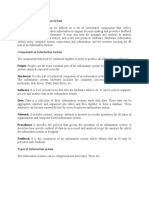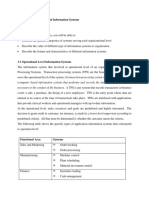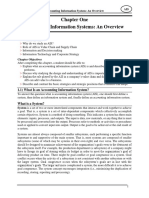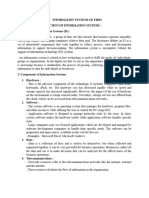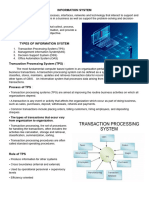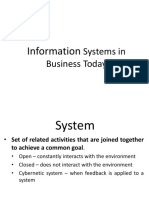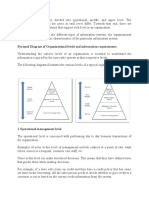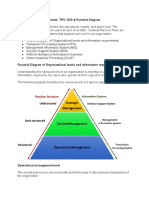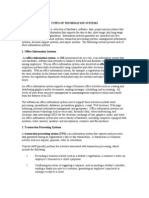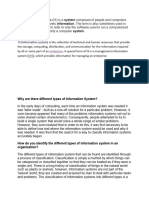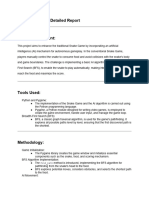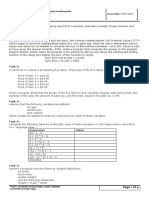HARAMBEE UNIVERSITY
DEPARTMENT: MASTER OF BUSINESS ADMINISTRATION
Program: On line
Assignment: one
Submitted By: Muluneh Paulos
Submitted To: Instructor Dr. Teklu Urgesssa (Associate Professor)
Year: 26/10/2023
1
� 1. Discuss the criteria up on which type information Systems can based
Information System
An information system is a set of interrelated components that works together to collect, process,
store and breakdown the information to support decision making. An information system can be
defined as set of coordinated network of components, which act together towards producing,
distributing and or processing information. An important characteristic of computer-based
information systems information is precision, which may not apply to other types.
Information systems are classified by organizational levels, mode of data processing, system
objectives, and by the type of support provided. Information Systems are classified by
organizational levels, mode of data, processing, system objectives and type of support provided.
In any given organization information system can be classified based on the usage of the
information.
We classify information systems based on the organizational level, business functions, and
business processes they support. Organization is divided into strategic, management, and
operational levels and then is further divided into functional areas, such as sales and marketing,
manufacturing and production, finance and accounting, and human resources. Three main
categories of information systems serve different organizational levels; operational-level
systems, management-level systems, and strategic-level systems. Operational-level systems
support operational managers by keeping track of the elementary activities and transactions of
the organization, such as sales, receipts, cash deposits, payroll, credit decisions, and the flow of
materials in a factory.
The organization has executive support systems (ESS) at the strategic level; management
information systems (MIS) and decision-support systems (DSS) at the management level; and
transaction processing systems (TPS) at the operational level. Systems at each level in turn are
specialized to serve each of the major functional areas. Thus, the typical systems found in
organizations are designed to assist workers or managers at each level and in the functions of
sales and marketing, manufacturing and production, finance and accounting, and human
resources. Thus Information System can be classified based on Functional Areas, Levels of
Management and Cross Functional Approaches.
2
� 2. Discuss Transaction Processing systems and Decision support systems
Transaction processing systems (TPS)
Transaction processing systems (TPS) are the basic business systems that serve the operational
level of the organization. A transaction processing system is a computerized system that
performs and records the daily routine transactions necessary to conduct business. Examples are
sales order entry, hotel reservation systems, payroll, employee record keeping, and shipping.
A transaction process system (TPS) is an information processing system for business transactions
involving the collection, modification and retrieval of all transaction data. Characteristics of a
TPS include performance, reliability and consistency. Transaction processing systems also
attempt to provide predictable response times to requests, although this is not as critical as real-
time systems.
At the operational level, tasks, resources, and goals are predefined and highly structured. The
decision to grant credit to a customer, for instance, is made by a lower-level supervisor according
to predefined criteria. All that must be determined is whether the customer meets the criteria.
Transaction Processing Systems are characterized by their rapid processing of data, reliability,
use of standard procedures, and control access. The activities of a typical TPS include data
collection, data editing, data correction, data manipulation, data storage, and document
production.
A TPS has the following four components. One must understand them to know how the system
works.
Inputs: Inputs are original requests for payments or products outside parties send to an
organization’s TPS. Typically, inputs include bills, coupons, custom orders, and invoices.
Output: Outputs are the documents a TPS generates after it processes all inputs, for example, the
receipts stored by companies in their records. Such documents help validate transactions and
offer crucial reference details for tax and multiple official purposes.
Storage: A TPS’s storage component is where organizations keep their output and input data.
Some businesses store the documents in a database. This component ensures the security,
accessibility, and organization of all documents for late use.
3
� Processing System: The processing system goes through every input and establishes a useful
output, for example, a receipt. It helps outline the input data and defines what the outputs must
be. One must remember that the processing time varies depending on the type of TPS an
organization uses.
Decision support systems
A decision support system (DSS) is a computerized program used to support determinations,
judgments, and courses of action in an organization or a business. A DSS sifts through and
analyzes massive amounts of data, compiling comprehensive information that can be used to
solve problems and in decision-making.
Decision-support systems (DSS) also serve the management level of the organization. DSS help
managers make decisions that are unique, rapidly changing, and not easily specified in advance.
They address problems where the procedure for arriving at a solution may not be fully
predefined in advance. Although DSS use internal information from TPS and MIS, they often
bring in information from external sources, such as current stock prices or product prices of
competitors.
Clearly, by design, DSS have more analytical power than other systems. They use a variety of
models to analyze data, or they condense large amounts of data into a form in which they can be
analyzed by decision makers. DSS are designed so that users can work with them directly; these
systems explicitly include user-friendly software. DSS are interactive; the user can change
assumptions, ask new questions, and include new data.
An interesting, small, but powerful DSS is the voyage-estimating system of a subsidiary of a
large American metals company that exists primarily to carry bulk cargoes of coal, oil, ores, and
finished products for its parent company. The firm owns some vessels, charters others, and bids
for shipping contracts in the open market to carry general cargo. A voyage-estimating system
calculates financial and technical voyage details. Financial calculations include ship/time costs
(fuel, labor, capital), freight rates for various types of cargo, and port expenses. Technical details
include a myriad of factors, such as ship cargo capacity, speed, port distances, fuel and water
consumption, and loading patterns (location of cargo for different ports).
4
�There are three main components in a decision support system:
1. DSS Database
The database contains information from multiple sources. It can either be a small database, a
standalone system, or an enormous data warehouse, depending on the organizational
requirements.
2. DSS Software System
The decision support system software is made up of mathematical and analytical models which
are utilized for the analysis of complex data. The models predict outputs based on inputs or
conditions or even combinations of inputs and conditions.
The decision support system could even have multiple models, each of them performing
particular tasks. The models could include statistical models, sensitivity analysis models,
optimization analysis models, forecasting models, and backward analysis sensitivity models.
3. DSS User Interface
This is the graphical user interface that makes it easy for users to interact with the decision
support system. It presents outputs as text, tables, charts, or graphics.
3. Discusses the stages of Information Systems development Process
The system development life cycle (SDLC) is an iterative, structured, and multistep process that
is used by teams to create high-quality information systems. It involves the activities of planning,
analysis, designing, building, testing, deploying, and maintaining a system that meets or exceeds
client expectations.
Systems development is the process of defining, designing, testing, and implementing a new
software application or program. Systems development is the art and science of creating man-
made systems to satisfy predetermined needs. It is a problem-solving process where we bring to
bear appropriate elements of mankind's knowledge base to create new knowledge specific to the
problem and, as a result, define a solution to the problem. In this book, we refer to organizations
that accomplish this work as system development enterprises, developers, or contractors that
5
�may, at any one time, be in the process of developing several systems, each through the exercise
of an organizational structure called a program.
Investigate
Conduct with a preliminary analysis, consider alternative solutions, estimate costs and benefits,
and submit a preliminary plan with recommendations. Identify the organization's objectives and
define the nature and scope of the project. Ensure that the project fits with the objectives.
Alternatives may come from interviewing employees, clients, suppliers, and consultants, as well
as competitive analysis. Cost-benefit analysis: Analyze the costs and benefits of the project.
This process is to identify the problems facing the company and the system it has. The team will
look for any opportunities that can be done to overcome this. The selection phase will apply
evaluation points to the development project to ensure the solutions are created in accordance
with the company’s expected targets. This step is the step of developing a formal plan to start
working on and implementing the information system development concept that has been
chosen.
Analyze
System requirements analysis is a technique for solving problems by decomposing the
components of the system. The aim is none other than to find out more about how each
component works and the interaction between each component with other components. Some
aspects that need to be targeted in the needs analysis in the development of information systems
include business users, job analysis, business processes, agreed rules, problems and solutions,
business tools, and business plans.
Design
The design or design of system development is intended to provide a complete blueprint as a
guideline for the IT team (especially programmers) in making applications. Thus the IT team no
longer makes decisions or works in a sporadic way.
6
� Implement
Once the new system is developed and tested, it has to be implemented in the organization. This
phase includes training the users, providing documentation, and conversion from any previous
system to the new system. Implementation can take many forms, depending on the type of
system, the number and type of users, and how urgent it is that the system becomes operational.
Maintain
This step covers the whole process in order to ensure the continuity, smoothness and
improvement of the system. In addition to monitoring the system at a certain time, maintenance
also includes activities to anticipate minor bugs (bugs), system improvements, and anticipation
of some risks from factors outside the system.
This final phase takes place once the implementation phase is complete. In this phase, the system
has a structured support process in place: reported bugs are fixed and requests for new features
are evaluated and implemented; system updates and backups are performed on a regular basis.
4. Briefly describe the management challenges of E-business enterprises
Technological advance of the last decades created an atmosphere in which the organizations are
forced to look actively for new options for the cost reduction, in addition to, simultaneously,
seeking to compete more effectively in their markets. This context requires focused, swift, more
flexible and more competitive organizations which are forced, many times, to implement radical
changes in the way they conduct business, employ people and use technology. Despite the
recognition and the attention given to electronic business (or e-business) over the last years, this
type of business hasn’t yet achieved a desirable maturity stage.
Affordable advertising, product variety, and global reach are important benefits. Technological
up gradation, returns, and counterfeits are the main challenges. The most significant challenges
are the risk of identity theft, payment fraud, and other types of cybercrime and e-commerce
platforms are vulnerable to cyber-attacks, leading to data breaches and loss of customer trust.
7
� The biggest and most common challenge faced by new e-commerce businesses is finding the
right niche. Entrepreneurs risk their financial security and ditch standard jobs to pursue their
dreams. The goal for many is to turn their hobbies into careers. And frankly, there's nothing
wrong with that. You should do what you love and make a living from it.
Another common challenge faced by new e-commerce businesses is finding the right
products to sell. Even if you've chosen a fitting niche to target, finding the right products is a
totally different ball game. The demand in the e-commerce industry is more volatile than
ever before. That's why we see hyped products every other day. However, such trends are
often short-lived. And after a few days, the products are no longer in demand.
The third most common challenge faced by new e-commerce businesses is sourcing the
selected products. Most e-commerce businesses have to make do with a limited budget when
getting started. This makes it difficult for them to source the selected products due to the cost
of warehousing.
When you've just started an e-commerce store, finding a relevant audience can be
challenging. A few years back, people readily made impulsive buying decisions and
purchased things on a whim. And this made targeting easier for e-commerce businesses.
Cyber security
Small businesses that focus their attention in the e-commerce space need policies and procedures
to create a solid cyber security framework for the organization. In the case of a cyber-attack, a
small business cannot afford to have downtime in operations and sales, because every transaction
is a marginal financial success that the business depends on.
Competition
Competition comes in many forms for small businesses, especially in the e-commerce space.
You have to keep up with competitive pricing, products and services – all competing for your
target customer.








